Promotional price valid on web orders only. Your contract pricing may differ. Interested in signing up for a dedicated account number?
Learn More
Learn More
HSP90 alpha/beta Llama anti-Human, Mouse, Rat, Polyclonal, Invitrogen™
Llama Polyclonal Antibody
Supplier: Thermo Scientific PA577825
Description
HSP90 is an abundantly and ubiquitously expressed heat shock protein. It is understood to exist in two principal forms alpha and beta, which share 85% sequence amino acid homology. The two isoforms of HSP90 are expressed in the cytosolic compartment. Despite the similarities, HSP90 alpha exists predomitly as a homodimer while HSP90 beta exists mainly as a monomer. From a functional perspective, HSP90 participates in the folding, assembly, maturation, and stabilization of specific proteins as an integral component of a chaperone complex. Furthermore, HSP90 is highly conserved between species; having 60% and 78% amino acid similarity between mammalian and the corresponding yeast and Drosophila proteins, respectively. HSP90 is a highly conserved and essential stress protein that is expressed in all eukaryotic cells. Despite its label of being a heat-shock protein, HSP90 is one of the most highly expressed proteins in unstressed cells (1-2% of cytosolic protein). It carries out a number of housekeeping functions - including controlling the activity, turnover, and trafficking of a variety of proteins. Most of the HSP90-regulated proteins that have been discovered to date are involved in cell signaling. The number of proteins now know to interact with HSP90 is about 100. Target proteins include the kinases v-Src, Wee1, and c-Raf, transcriptional regulators such as p53 and steroid receptors, and the polymerases of the hepatitis B virus and telomerase. When bound to ATP, HSP90 interacts with co-chaperones Cdc37, p23, and an assortment of immunophilin-like proteins, forming a complex that stabilizes and protects target proteins from proteasomal degradation.In most cases, HSP90-interacting proteins have been shown to co-precipitate with HSP90 when carrying out immunoadsorption studies, and to exist in cytosolic heterocomplexes with it. In a number of cases, variations in HSP90 expression or HSP90 mutation has been shown to degrade signaling function via the protein or to impair a specific function of the protein (such as steroid binding, kinase activity) in vivo. Ansamycin antibiotics, such as geldanamycin and radicicol, inhibit HSP90 function.
Specifications
| HSP90 alpha/beta | |
| Polyclonal | |
| Unconjugated | |
| HSP90AA1 | |
| Heat shock 84 kDa, Heat shock 86 kDa, Heat shock protein HSP 90-alpha, Heat shock protein HSP 90-beta, HSP 84, HSP 86, HSP 90, HSP84, HSP86, HSP90A, HSP90AA1, HSP90AB1, HSP90B, HSPC1, HSPC2, HSPCA, HSPCB, LAP-2, Lipopolysaccharide-associated protein 2, LPS-associated protein 2, Renal carcinoma antigen NY-REN-38 | |
| Llama | |
| Antigen affinity chromatography | |
| RUO | |
| 15519, 299331, 3320 | |
| -20°C | |
| Liquid |
| ELISA, Western Blot | |
| 1 mg/ml | |
| PBS with 50% glycerol and 0.09% sodium azide; pH 7.4 | |
| P07900, P07901, P82995 | |
| HSP90AA1 | |
| Synthetic human HSP90 alpha full length protein | |
| 100 μg | |
| Primary | |
| Human, Mouse, Rat | |
| Antibody | |
| Ig |
Product Content Correction
Your input is important to us. Please complete this form to provide feedback related to the content on this product.
Product Title
Spot an opportunity for improvement?Share a Content Correction
